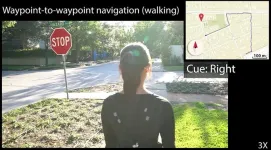(Press-News.org) HOUSTON – (Aug. 29, 2023) Personal devices feed our sight and hearing virtually unlimited streams of information while leaving our sense of touch mostly … untouched.
A wearable, textile-based device developed by Rice University engineers could help declutter, enhance — and, in the case of impairments — compensate for deficiencies in visual and auditory inputs by tapping this underused sensory resource.
“Technology has been slow to co-opt haptics or communication based on the sense of touch,” said Barclay Jumet, a mechanical engineering PhD student who is the lead author on a study published in Device. “Of the technologies that have incorporated haptics, wearable devices often still require bulky external hardware to provide complex cues, limiting their use in day-to-day activities.”
The system of haptic accessories built by the Rice labs of Daniel Preston and Marcia O’Malley reduces the need for hardware by programming haptic cues into the textile structure of the wearables using fluidic control, building on an approach described in prior work.
“With a traditional control system using voltage and current, you’d typically need many electronic inputs to achieve complex haptic cues,” said Preston, an assistant professor of mechanical engineering at Rice whose lab explores the intersection of energy, materials and fluids. “In this device, we’ve offloaded a lot of that complexity to the fluidic controller and require only a very limited number of electronic inputs to provide sophisticated haptic stimulation.”
Comprised of a belt and textile sleeves, the wearables rely on fluidic signals — such as pressures and flow rates — to control the delivery of complex haptic cues, including sensations like vibration, tapping and squeezing. A small, lightweight carbon dioxide tank affixed to the belt feeds airtight circuits incorporated in the heat-sealable textiles, causing quarter-sized pouches — up to six on each sleeve — to inflate with varying force and frequency.
In an experiment demonstrating the device’s utility for real-world navigation, these cues served as directions guiding a user on a mile-long route through the streets of Houston. In another experiment, a user outlined invisible Tetris pieces in a field by following the directions conveyed to them through the haptic textiles.
“The belt incorporates a slimmed-down version of the electronic control system that might otherwise be required,” Jumet said. “In this case, we had twelve pouches across two sleeves progressively inflate to indicate one of four directions: forward, backward, left or right. So instead of requiring twelve electronic inputs, we embed that complexity into the sleeve and are able to use only four inputs — a reduction by two-thirds.
“In the future, this technology could be directly integrated with navigational systems, so that the very textiles making up one’s clothing can tell users which way to go without taxing their already overloaded visual and auditory senses — for instance by needing to consult a map or listen to a virtual assistant.”
Moreover, the wearable textile device could incorporate other sensing and control mechanisms to allow users with limited vision or hearing to detect obstacles and navigate dynamic environments in real time.
“Devices like this could, for instance, be helpful for people suffering from hearing loss,” said O’Malley, chair of the Department of Mechanical Engineering and the Thomas Michael Panos Family Professor in Mechanical Engineering, Electrical and Computer Engineering, Bioengineering and Computer Science at Rice.
Cochlear implants can restore speech perception for people with severe hearing loss, but the literature shows that these individuals still struggle to understand speech in noisy environments and can experience difficulty locating the sources of sounds. Haptic feedback has the potential to enhance cochlear implant performance or make lip-reading easier for patients.
“You’ll have better recognition and interpretation of the sounds processed by the cochlear implant if they’re reinforced with haptic cues conveying the same information encoded in a different way,” O’Malley said.
Another application example is restoring the sense of touch for an amputee by embedding sensors on a prosthesis to gather data that the wearables could relay as haptic feedback elsewhere on the body.
“The haptic feedback experienced by the user would in this case be directly correlated with the actions they’re taking,” said O’Malley, who directs the Mechatronics and Haptic Interfaces Lab at Rice. “One of the big advantages with using these smart textiles for haptic devices is that they bring a lot more freedom and flexibility to the design space. We’re no longer constrained by the size or geometry of components that need to be incorporated into a design.”
The heat-sealable textiles are resilient to wear and tear, making the device suitable for intensive daily use.
“We tested the durability of our haptic textiles by washing a device 25 times then cutting it open with a knife and ironing a textile patch over the cut,” Jumet said. “It continued to work as intended after repeated washing, cutting and repairing.”
Jumet expressed the hope that, in addition to serving as the basis for medically-useful applications, haptic textiles could “enable a more immersive and seamlessly-connected world.”
“Instead of a smart watch with simple vibrational cues, we can now envision a ‘smart shirt’ that gives the sensation of a stroking hand or a soft tap on the torso or arm,” he said. “Movies, games and other forms of entertainment could now incorporate the sense of touch, and virtual reality can be more comfortable for longer periods of time.”
The research was supported by the National Science Foundation (1830146, 2144809, 1842494), the Rice University Academy of Fellows and the Gates Millennium Scholars Program.
-30-
This release can be found online at news.rice.edu.
Follow Rice News and Media Relations via Twitter @RiceUNews.
Peer-reviewed paper:
“Fluidically Programmed Wearable Haptic Textiles” | Device | DOI: 10.1016/j.device.2023.100059
Authors: Barclay Jumet, Zane Zook, Anas Yousaf, Anoop Rajappan, Doris Xu, Te Yap, Nathaniel Fino, Zhen Liu, Marcia O’Malley and Daniel Preston
https://doi.org/10.1016/j.device.2023.100059
Video:
Video URL: https://youtu.be/6KHVXg1R0Y8
(Video by Brandon Martin/Rice University)
Image downloads:
https://news-network.rice.edu/news/files/2023/08/829_Wearable-Haptics_researchers_Lg.jpg
CAPTION: Marcia O'Malley (from left), Barclay Jumet and Daniel Preston developed a wearable textile device that can deliver complex haptic cues in real time to users on the go.
(Photo by Brandon Martin/Rice University)
https://news-network.rice.edu/news/files/2023/08/230824_Wearable-Haptic-Feedback-Mechanical-Engineering_Martin-88.jpg
CAPTION: Barclay Jumet is lead author on a study published in Device.
Related stories:
Hands-free tech adds realistic sense of touch in extended reality:
https://news.rice.edu/news/2023/hands-free-tech-adds-realistic-sense-touch-extended-reality
Wearables take ‘logical’ step toward onboard control:
https://news.rice.edu/news/2022/wearables-take-logical-step-toward-onboard-control
Rice engineers get a grip with ‘necrobotic’ spiders:
https://news.rice.edu/news/2022/rice-engineers-get-grip-necrobotic-spiders
Powering an ‘arm’ with air could be mighty handy:
https://news.rice.edu/news/2022/powering-arm-air-could-be-mighty-handy
Rice tapped to develop 3D-printed ‘smart helmets’ for the military:
https://news.rice.edu/news/2021/rice-tapped-develop-3d-printed-smart-helmets-military
Links:
Preston Innovation Laboratory: https://pi.rice.edu
Mechatronics and Haptic Interfaces lab: https://mahilab.rice.edu/
Department of Mechanical Engineering: https://mech.rice.edu
George R. Brown School of Engineering: https://engineering.rice.edu/
Located on a 300-acre forested campus in Houston, Rice University is consistently ranked among the nation’s top 20 universities by U.S. News & World Report. Rice has highly respected schools of Architecture, Business, Continuing Studies, Engineering, Humanities, Music, Natural Sciences and Social Sciences and is home to the Baker Institute for Public Policy. With 4,552 undergraduates and 3,998 graduate students, Rice’s undergraduate student-to-faculty ratio is just under 6-to-1. Its residential college system builds close-knit communities and lifelong friendships, just one reason why Rice is ranked No. 1 for lots of race/class interaction and No. 4 for quality of life by the Princeton Review. Rice is also rated as a best value among private universities by Kiplinger’s Personal Finance.
If you do not wish to receive news releases from Rice University, reply to this email and write “unsubscribe” in the subject line. Office of News and Media Relations – MS 300, Rice University, 6100 Main St., Houston, TX 77005.
END
Smart fabrics’ informed touch can tell you where to go
Wearable textile-based device delivers complex, on-the-go haptic input
2023-08-29
ELSE PRESS RELEASES FROM THIS DATE:
AI-powered triage platform could aid future viral outbreak response
2023-08-29
AI-powered triage platform could aid future viral outbreak response
New Haven, Conn. —A team of researchers from Yale University and other institutions globally has developed an innovative patient triage platform powered by artificial intelligence (AI) that the researchers say is capable of predicting patient disease severity and length of hospitalization during a viral outbreak.
The platform, which leverages machine learning and metabolomics data, is intended to improve patient management and help health care providers allocate resources more efficiently during severe viral outbreaks that can quickly overwhelm local health care systems. Metabolomics ...
Study identifies geographic ‘hot spots’ for cigarette, firearm deaths in the US over two decades
2023-08-29
Smoking and firearms are among the leading causes of avoidable premature death in the United States. In 2021, 480,000 deaths in the U.S. were attributable to tobacco and more than 40,000 to firearms – both are legal yet lethal.
A new study from Florida Atlantic University’s Schmidt College of Medicine, and collaborators, now reveals geographically distinct areas of the highest death rates in the U.S. related to cigarettes as well as firearms, including both assault and suicide over two decades.
Results, published online ahead of print in the peer-reviewed journal Preventive Medicine, show all three measures – smoking, firearm-related assault and firearm-related ...
Jefferson Lab receives 2023 EPEAT Purchaser Award
2023-08-29
NEWPORT NEWS, VA – Staff and scientific users at the U.S. Department of Energy’s Thomas Jefferson National Accelerator Facility need all kinds of electronics to do their jobs, including computers, smartphones, printers and more. But instead of buying just any laptop off the shelf, the lab takes care to buy devices that meet sustainability standards when possible.
During a virtual ceremony on July 27, the Global Electronics Council presented Jefferson Lab with a 2023 EPEAT Purchaser Award for buying sustainable electronics in fiscal year 2022.
These devices meet ...
Male crested macaques more likely to respond to offspring screams recruiting support
2023-08-29
When infants are involved in agonistic conflicts, male crested macaques (Macaca nigra) are more likely to respond to screams from their own offspring. This is the conclusion of a recent study led by behavioural ecologist Professor Anja Widdig from Leipzig University and the Max Planck Institute for Evolutionary Anthropology in Leipzig as part of the Macaca Nigra Project (MNP). The researchers studied the behaviour of crested macaques in the Tangkoko Nature Reserve on Sulawesi, Indonesia, over a 24-month period (2008 to 2010). A special issue of the “International ...
CDI study of fevers in children during COVID-19 raises further questions
2023-08-29
An uptick in fevers detected among children at more than two dozen hospitals in North America during COVID-19 highlights the question whether there are normally more autoinflammatory disorders such as recurrent fevers among children going overlooked in non-pandemic times, according to a new study by researchers including a CDI physician-scientist.
The paper “Increase in pediatric recurrent fever evaluations during the first year of the COVID-19 pandemic in North America” was published by Frontiers in Pediatrics on Aug. 3, and includes Sivia Lapidus, M.D., pediatric rheumatologist, Joseph M. Sanzari Children’s ...
Study sheds light on why breast cancer survivors don’t take their medications, and what can be done about it
2023-08-29
For roughly 80% of breast cancer survivors, treatment doesn’t end with surgery, radiation and chemotherapy. Instead, for the next five to 10 years, doctors recommend that they take medication to block sex hormones, which can fuel tumor growth and spark recurrence.
The drugs, no doubt, are life-saving: they’ve been shown to cut risk of cancer recurrence by as much as half in patients with hormone receptor-positive tumors (HR+)—the most common form of breast cancer. Yet despite their promised benefits, 40% of patients stop taking them early and a third take them less frequently than directed.
New CU ...
Neural network helps design brand new proteins
2023-08-29
WASHINGTON, August 29, 2023 – With their intricate arrangements and dynamic functionalities, proteins perform a plethora of biological tasks by employing unique arrangements of simple building blocks where geometry is key. Translating this nearly limitless library of arrangements into their respective functions could let researchers design custom proteins for specific uses.
In Journal of Applied Physics, from AIP Publishing, Markus Buehler of the Massachusetts Institute of Technology combined attention neural networks, often referred to as transformers, with graph neural ...
Some hosts have an “evolutionary addiction” to their microbiome
2023-08-29
We’ve long known that hosts malfunction without their microbiome—whether they are missing key microbial species or are completely microbe free. This malfunctioning is usually explained by the need for microbes to perform unique and beneficial functions, but evolutionary ecologist Tobin Hammer of the University of California, Irvine, is questioning that narrative.
In a peer-reviewed opinion article publishing August 29 in the journal Trends in Microbiology, Hammer argues that, in some cases, microbes might not actually be helping their hosts; instead, microbe-free hosts might malfunction because they have evolved an addiction to their microbes. ...
A lightweight wearable device helps users navigate with a tap on the wrist
2023-08-29
Scientists at Rice University in Houston, Texas have developed a fabric-based wearable device that “taps” a user’s wrist with pressurized air, silently helping them navigate to their destination. The study, published August 29 in the journal Device, demonstrated that users correctly interpreted which direction the device was telling them to go an average of 87% of the time. Since the wearable embeds most of its control system within the fabric itself, using air instead of electronics, it can be built lighter and more compact than existing designs.
“We envision this device will be used by individuals who need or desire information to be transmitted ...
Long-term maternal and child outcomes following postnatal SSRI treatment
2023-08-29
About The Study: The results of this study of 61,000 mother-child dyads suggest that postnatal selective serotonin reuptake inhibitor (SSRI) treatment was associated with a reduced risk of postnatal depression–associated maternal mental health problems and child externalizing behaviors across early childhood years. These findings suggest that postnatal SSRI treatment may bring benefits in the long term to women with postnatal depression and their offspring.
Authors: Chaoyu Liu, M.D., Ph.D., of King’s College in London, is the corresponding author.
To access the ...
LAST 30 PRESS RELEASES:
Sleeping in on weekends may help boost teens’ mental health
Study: Teens use cellphones for an hour a day at school
After more than two years of war, Palestinian children are hungry, denied education and “like the living dead”
The untold story of life with Prader-Willi syndrome - according to the siblings who live it
How the parasite that ‘gave up sex’ found more hosts – and why its victory won’t last
When is it time to jump? The boiling frog problem of AI use in physics education
Twitter data reveals partisan divide in understanding why pollen season's getting worse
AI is quick but risky for updating old software
Revolutionizing biosecurity: new multi-omics framework to transform invasive species management
From ancient herb to modern medicine: new review unveils the multi-targeted healing potential of Borago officinalis
Building a global scientific community: Biological Diversity Journal announces dual recruitment of Editorial Board and Youth Editorial Board members
Microbes that break down antibiotics help protect ecosystems under drug pollution
Smart biochar that remembers pollutants offers a new way to clean water and recycle biomass
Rice genes matter more than domestication in shaping plant microbiomes
Ticking time bomb: Some farmers report as many as 70 tick encounters over a 6-month period
Turning garden and crop waste into plastics
Scientists discover ‘platypus galaxies’ in the early universe
Seeing thyroid cancer in a new light: when AI meets label-free imaging in the operating room
Neutrophil-to-lymphocyte ratio may aid risk stratification in depressive disorder
2026 Seismological Society of America Annual Meeting
AI-powered ECG analysis offers promising path for early detection of chronic obstructive pulmonary disease, says Mount Sinai researchers
GIMM uncovers flaws in lab-grown heart cells and paves the way for improved treatments
Cracking the evolutionary code of sleep
Medications could help the aging brain cope with surgery, memory impairment
Back pain linked to worse sleep years later in men over 65, according to study
CDC urges ‘shared decision-making’ on some childhood vaccines; many unclear about what that means
New research finds that an ‘equal treatment’ approach to economic opportunity advertising can backfire
Researchers create shape-shifting, self-navigating microparticles
Science army mobilizes to map US soil microbiome
Researchers develop new tools to turn grain crops into biosensors
[Press-News.org] Smart fabrics’ informed touch can tell you where to goWearable textile-based device delivers complex, on-the-go haptic input







